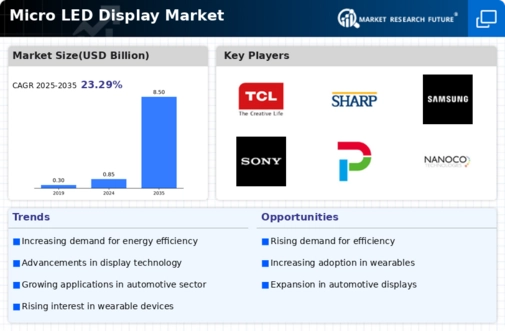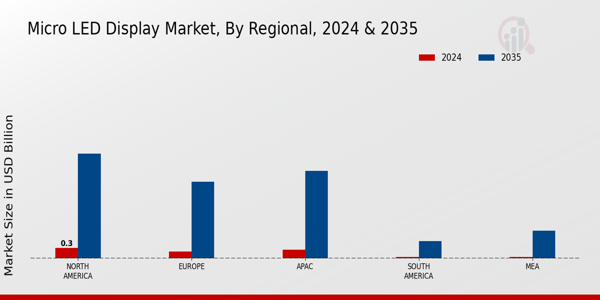Market Share
Introduction: Navigating the Competitive Landscape of Micro LED Displays
The micro-LED display market is seeing unprecedented competition, driven by rapid technology adoption and consumers’ evolving demand for a superior visual experience. In order to gain a leadership position, key players, such as original equipment manufacturers (OEMs), IT systems integrators, and hardware vendors, are deploying advanced technologies, such as AI-based analytics and IoT integration, to improve product performance and operational efficiency. These established players are also being challenged by new entrants, such as green and automation-focused startups. Strategic deployments are increasingly tailored to meet the unique needs of each regional market, especially in Asia-Pacific and North America. The combination of these factors is not only reshaping market share, but also laying the groundwork for a new era of display technology. Those who fail to adapt will not survive.
Competitive Positioning
Full-Suite Integrators
These vendors provide comprehensive solutions, integrating hardware and software for Micro LED displays.
| Vendor | Competitive Edge | Solution Focus | Regional Focus |
|---|---|---|---|
| Samsung | Leading in display technology innovation | Micro LED display solutions | Global |
| LG Electronics | Strong brand with diverse product range | Micro LED and OLED displays | Global |
| Sony | High-quality imaging and display expertise | Professional Micro LED displays | Global |
Specialized Technology Vendors
These companies focus on specific technologies or components essential for Micro LED displays.
| Vendor | Competitive Edge | Solution Focus | Regional Focus |
|---|---|---|---|
| PlayNitride | Expertise in Micro LED chip technology | Micro LED chips and modules | Asia, Global |
| Nanoco Technologies | Leader in quantum dot technology | Quantum dots for Micro LED displays | Global |
| Epistar | Pioneering LED chip manufacturer | LED components for Micro LED | Asia, Global |
Infrastructure & Equipment Providers
These vendors supply the necessary infrastructure and equipment for manufacturing Micro LED displays.
| Vendor | Competitive Edge | Solution Focus | Regional Focus |
|---|---|---|---|
| AU Optronics | Strong in display manufacturing technology | Display panels and manufacturing equipment | Asia, Global |
| Micron Technology | Expertise in memory and storage solutions | Memory solutions for display technologies | Global |
| Intel | Advanced semiconductor technology | Processing solutions for displays | Global |
Consumer Electronics Giants
These companies leverage their consumer electronics expertise to enter the Micro LED display market.
| Vendor | Competitive Edge | Solution Focus | Regional Focus |
|---|---|---|---|
| TCL | Aggressive pricing and innovation | Consumer Micro LED displays | Global |
| Xiaomi | Strong market presence and affordability | Smart consumer displays | Asia, Global |
| Apple | Brand loyalty and ecosystem integration | High-end consumer displays | Global |
| Integration with software and services | Smart display solutions | Global | |
| JBD | Focus on microdisplay technology | Micro LED microdisplays | Global |
Display Panel Manufacturers
These vendors specialize in the production of display panels, including Micro LED technology.
| Vendor | Competitive Edge | Solution Focus | Regional Focus |
|---|---|---|---|
| Sharp | Innovative display technologies | Display panels for various applications | Asia, Global |
Emerging Players & Regional Champions
- VueReal (Canada): VueReal specializes in micro-LED technology for high-resolution applications, and has recently entered into a partnership with a major carmaker for in-car displays. It is challenging the established vendors such as Samsung and LG by offering solutions tailored to the needs of the market.
- - JBD (China) - The company specializes in micro-LED displays for wearables and AR applications, and has recently signed a contract with a major technology company to develop smart glasses, and is positioned as a new entrant in the industry by providing a small and efficient display.
- NITRIDE PLAY (Taiwan): The company specializes in the development of micro-LED displays and digital signs, and has recently been involved in a large-scale sports event. Its micro-LED display is brighter and more energy-efficient than conventional products, and it can be used for outdoor advertising.
- ROHRM (Japan) - a manufacturer of micro-LED drivers and components, has recently teamed up with a display manufacturer to improve the power efficiency of micro-LEDs. Compared to the traditional semiconductor suppliers, specialized in micro-LED solutions.
Regional Trends: In 2024, the micro-LED display market is expected to witness significant growth in the regions of North America and Asia-Pacific. North America is leading the industry in terms of innovation and high-end applications, while Asia-Pacific is rapidly gaining ground in terms of manufacturing and cost-effective solutions. Companies are focusing on enhancing the brightness, energy efficiency, and customization of products to gain a competitive edge.
Collaborations & M&A Movements
- Samsung Display and LG Display entered a partnership to jointly develop next-generation Micro LED technology, aiming to enhance their competitive positioning in the premium display segment.
- Apple acquired a minority stake in a Micro LED startup, aiming to secure advanced display technologies for its future product lines, thereby strengthening its market share in the high-end consumer electronics sector.
- Sony and Sharp announced a collaboration to create a new line of Micro LED displays for commercial applications, intending to leverage their combined expertise to capture a larger share of the growing professional display market.
Competitive Summary Table
| Capability | Leading Players | Remarks |
|---|---|---|
| High Brightness and Color Accuracy | Samsung, Sony | The nits of the micro LEDs are as high as 2,000, which makes them suitable for use outdoors. The Sony Crystal LED display has been used for prestigious events such as the Tokyo Olympic Games in 2020. |
| Scalability and Modular Design | LG Display, Barco | LG Display's modular Micro LED panels allow for flexible configurations, catering to various screen sizes and shapes. Barco's solutions are designed for easy scalability, enabling seamless integration in large venues like stadiums and auditoriums. |
| Energy Efficiency | Apple, Sharp | Energy-saving micro-LED technology developed by Apple is designed to reduce power consumption by a factor of ten in comparison with a conventional display. But it is the micro-LED technology developed by Sharp that is suitable for commercial use. |
| Durability and Longevity | Innolux, AU Optronics | Innolux's Micro LED displays are designed for long-term use with high durability ratings, making them suitable for industrial applications. AU Optronics emphasizes longevity in their products, with a lifespan exceeding 100,000 hours. |
| Integration with Smart Technologies | Philips, ViewSonic | Philips has integrated smart technology into their Micro LED displays, allowing for IoT connectivity and enhanced user interaction. ViewSonic's displays support advanced features like wireless connectivity and smart content management systems. |
Conclusion: Navigating the Micro LED Landscape
The competition in the micro-LED display market in 2024 will be characterized by a growing trend of fragmentation, with both old and new players competing for market share. The old players will continue to rely on their brand and technical advantages, while the new entrants will rely on innovation and application to carve out their own markets. The Asia-Pacific and North American regions will be the most developed, with the most prominent development in the field of automobiles and consumer electronics. The market will be driven by the trend of the Internet of Things, and the main forces will be AI+, automation, green materials, and flexible design. The ability to adapt to the trend will be the key to survival for companies in this fast-changing market.















Leave a Comment